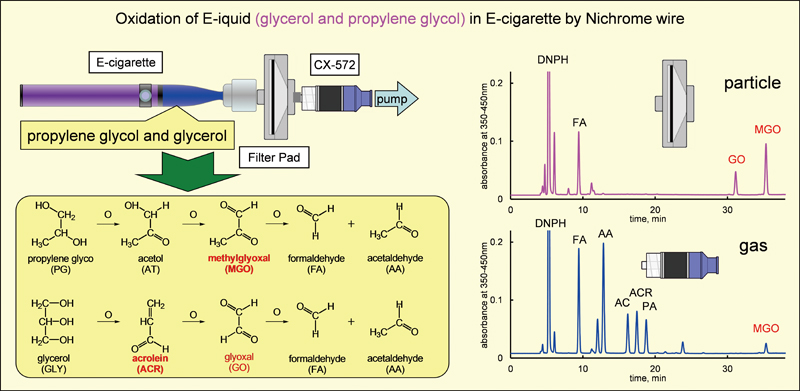Abstract
We developed an analytical method for analyzing electronic cigarette (E-cigarette) smoke, and measured the carbonyl compounds and volatile organic compounds generated by 10 brands of second-generation E-cigarettes. A glass filter (Cambridge filter pad) for particulate matter and a solid sorbent tube packed with Carboxen-572 for gaseous compounds were used to collect E-cigarette smoke. These were then analyzed using a two-step elution method with carbon disulfide and methanol, followed by high-performance liquid chromatography (HPLC) and gas chromatography mass spectrometry (GC/MS). Formaldehyde (FA), acetaldehyde (AA), acetone (AC), acrolein (ACR), propanal (PA), acetol (AT), glyoxal (GO), and methyl glyoxal (MGO) were detected by HPLC in some E-cigarettes. Propylene glycol (PG), glycerol (GLY), and some esters were detected by GC/MS. GO and MGO exist mainly as particulate matter. AA, AC, ACR, PA, and AT exist mainly as gaseous compounds. FA exists as both particulate matter and gaseous compounds. These carbonyl compounds have carbon numbers C1 – C3. The main components of E-liquid are PG (C3) and GLY (C3). Therefore, the oxidation of liquids, such as PG and GLY in E-cigarettes upon incidental contact with the heating element in E-cigarette, is suggested as being a possible cause for carbonyl generation. When the puff number exceeds a critical point, carbonyl generation rapidly increases and then remains constant. The results of this study are now being used to determine the following E-cigarette smoking protocol: puff volume, 55 mL; puff duration, 2 s; and puff number, 30. E-cigarette analysis revealed very large variation in carbonyl concentration among not only different brands, but also different samples of the same product. Typical distributions of carbonyl concentration were not observed in any of the E-cigarettes tested, and the mean values greatly differed from median values.
